“I’ll be waiting… for you…so… if you come here… you’ll find me.”
When it came to replaying Final Fantasy VIII for this retrospective, I was spoilt for choice. It’d been notably absent from the Final Fantasy remasters for the longest time, leading to speculation as to whether we’d see a re-release at all. Thankfully, the game has finally made its way to modern systems, giving a convenient way to experience what many would refer to as the black sheep of the series. With options for making the traditional JRPG experience more forgiving, it’s certainly the most sensible way to revisit the game. For me however, Final Fantasy VIII has always existed in a particular time and place in my life. I had to play it just as I remembered it—blocky polygons and all. I had to remind myself of what it meant to me as a teenager.
As a passionate Nintendo fan, I’d been late to the party with Final Fantasy VII. Despite my schoolmates’ adoration of Sony’s 32-bit console, I’d held off the temptation to stray from the N64 until January 1999. I remember picking up my Playstation console from Electronics Boutique along with a Platinum copy of Final Fantasy VII. Inside was a demo disc of the upcoming Final Fantasy VIII.
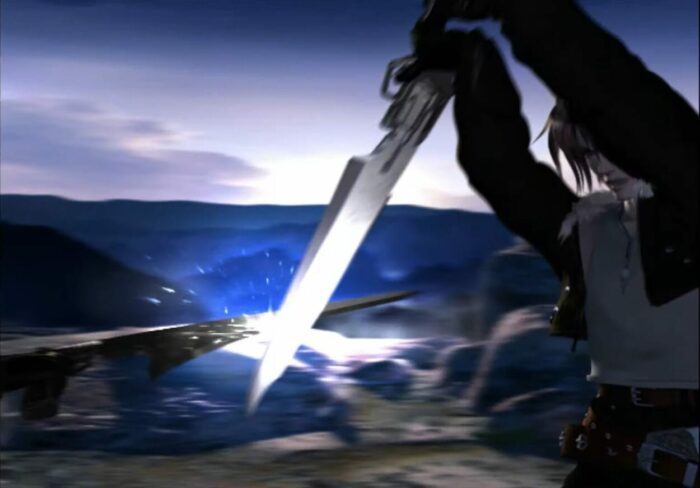
The demo contained a trailer showing off the game’s state-of-the-art CG cutscenes. The first was, to this day, one of the most exciting trailers I’ve ever seen. I watched it repeatedly to the point where I’ve been able to remember it scene-for-scene ever since. The opening shot of the lapping waves, the ominous choral music, the runaway train, the elegant sorceress, a girl in a field of flower petals, the clash of gun-blades, the splash of blood. I’d never seen anything like it. I was none the wiser regarding the game’s plot, but the sheer emotion of it resonated with me deeply. Tantalising scenes of anger, pride, frustration, fear, and love crammed into a three-minute video.
I would later learn the names of the main characters shown. Squall the stoic protagonist who I’d seen duelling on a rocky plateau. Seifer, his arrogant arch-rival, who climactically draws first blood. Rinoa, the girl showered in petals who magically transforms one into a feather and falls emotionally into Squall’s arms. And Edea, the dark, beautiful sorceress who serves as the (initial) antagonist of the story.
“Life and death, victory and defeat, honor and disgrace… Each of these go hand in hand.” – Headmaster Cid, FFVIII
The game would release in the west in the autumn of 1999—two years after its predecessor and carrying a weight of expectation. Final Fantasy VII had introduced a large new audience to the JRPG genre. It was the first game in the series to be released in PAL regions and its impact worldwide had been immeasurable. Squaresoft, never short of ambition, wanted Final Fantasy VIII to push every aspect of the series to new heights.
I’ve already mentioned the incredible work that went into the game’s cutscenes. The aforementioned trailer serves as the game’s opening cutscene, but also gives glimpses of scenes to come. It’s hard to put into words just how impressive they looked in 1999. Looking back at VII’s cutscenes, if you didn’t know better, you’d swear they were a hardware generation apart.
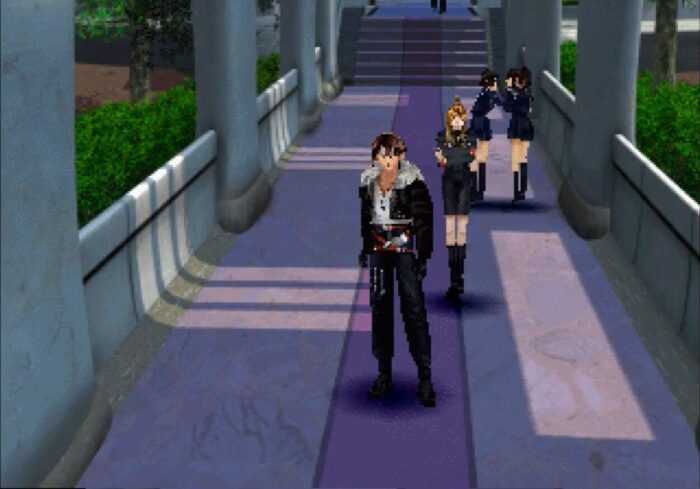
This graphical leap wasn’t limited to the cutscenes either. Whereas Cloud’s in-game character had been a chibi-like approximation of a human, Squall was realistically proportioned and impressively detailed. The pre-rendered backgrounds were back but no longer were they limited to just static images. Trains pull into stations, water flows from fountains, and the camera changes focus from foreground to background. By some wizardry, CG cutscenes could blend seamlessly into gameplay (bar the polygonal character models of course). Final Fantasy VIII was a technical masterclass for the Playstation.
“I’m more complex than you think.” – Squall, FFVIII
Though the core Final Fantasy experience remained intact, many gameplay elements were radically changed. Magic points, learned spells, stat-boosting gear—gone. What replaced it was the ‘Guardian Forces’ system—GF for short. Commonly regarded as one of the most confusing and convoluted in the franchise, the GF system is how Final Fantasy VIII earned its black sheep reputation.
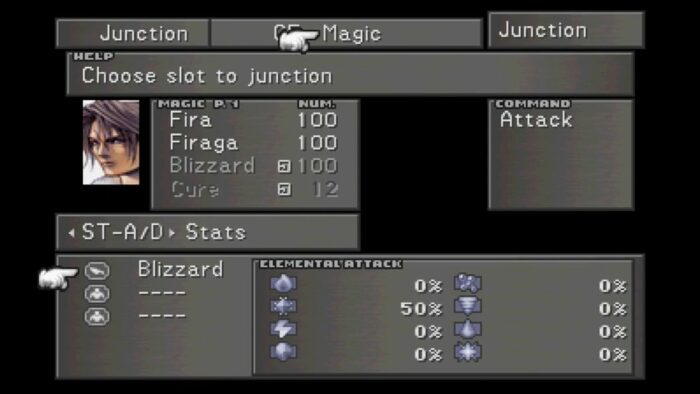
Characters, by default, can only perform basic attacks. To access further commands such as items, magic and summons, a character must be ‘junctioned’ to a GF. The player must then go to a menu to select the commands they wish to access in battle. Here they can also select any passive abilities which may have been unlocked. A junctioned GF will also allow certain attributes to be buffed with spells. For instance, junctioning Ifrit to Squall allows him to assign a spell to his strength stat, thereby increasing it—much like gear would in previous games. A further menu lies beneath this one, where spells can be linked to the character’s weapon, and defence. For instance, you could assign Blizzard to your weapon, and Fire to your defence when fighting against the enemies in the fire cavern area.
Confused yet? So were we. The system certainly has its defenders. To be fair, it works well once you start focusing on the numbers, but everything about it seems so counterintuitive. Why does this Blizzard spell increase my spirit stat but this Fire doesn’t? What happens if I assign Cure to my defence? If I assign Thunder to my magic stat will all spells deal more damage or just Thunder?
Everyone understood the traditional gear system. Leather armour is better than no armour, chainmail is even better, plate is better still, and so it goes on. A sword with a fancy name is probably going to be better than one with a generic descriptor. At the end of the day, it all boils down to seeing numbers going up or down, but Final Fantasy VIII’s attempt to fix something that wasn’t broken has been a point of contention since its release.
“…I don’t need you to understand me.” – Squall, FFVIII
Spell casting was also radically different. No longer would characters learn spells in the traditional sense. Instead, for characters to be able to use magic they need to be given the ‘draw’ command. Using draw in battle allows the character to essentially sap spells from enemies. Each enemy has a specific set of spells that can be drawn from and each character can stockpile 99 of them. This led to many players feeling a compulsion to painstakingly horde spells from enemies rather than actually attacking them. Hardly a riveting prospect.
At the time, I didn’t think much of it. As I mentioned earlier, in my part of the world, Final Fantasy VII was most people’s first exposure to JRPGs. Final Fantasy VIII was the second JRPG I’d ever played and so I didn’t really have a preconceived idea of what it should be. The graphics looked completely different, so why shouldn’t the gameplay be different too? I can imagine log time fans in America and Japan having an understandably different reaction though.
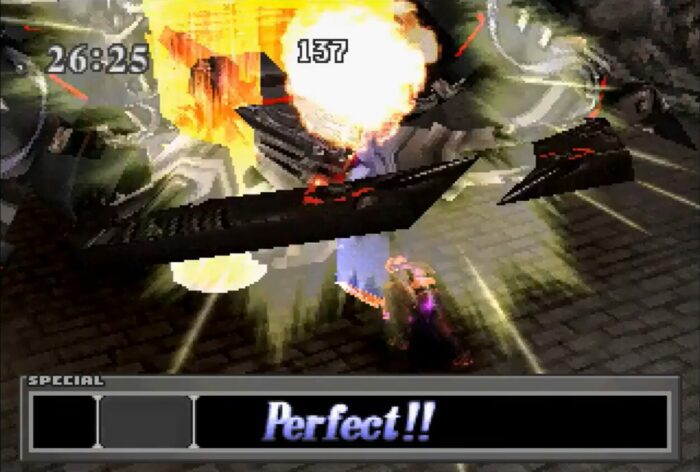
One aspect of the gameplay that was more universally appreciated was the inclusion of timed attacks. By pressing the R1 button just as the attack lands, Squall’s gunblade can be triggered to deal additional damage. Combined with the Dualshock’s vibration feature it makes for an extremely satisfying feeling. It also gives the player a reason to remain focused during the turn-based combat. Additionally, limit-breaks (where a character who is low on health, is able to unleash a flurry of moves) also use a variety of quick-time button inputs. Rapidly firing off combinations during Zell’s Duel, or timing critical hits with Squall’s Renzokuken is absolutely exhilarating.
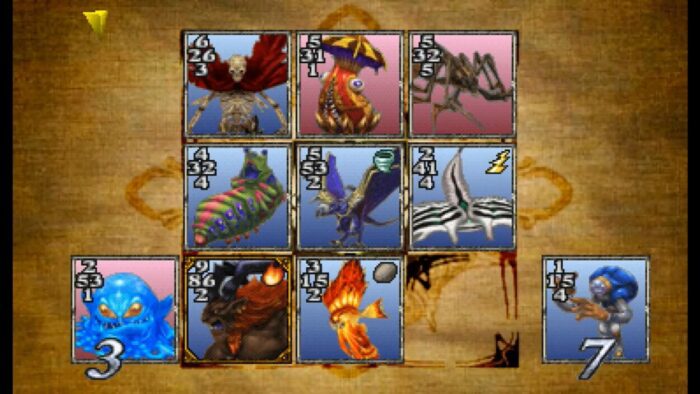
Another first for the Final Fantasy series was the inclusion of a trading card minigame: Triple Triad. A large number of the NPCs found in the game can be challenged. A 3×3 grid is laid out and the player and NPC take turns in placing their cards on it. Each card is representative of an enemy, character or GF. Each has a number between one and nine printed on each of the four sides of the card. If you place a card next to an opponent’s card the values on the touching sides are compared. If the newly placed card has a higher value, then the opponent’s card will be taken over. Whoever controls the most cards after filling the grid wins the match and an opponent’s card as a prize. It’s a simple but highly addictive little game that’s easy to lose hours to.
“You’re-going-to-like-me! You’re-going-to-like-me! Did it work?” – Rinoa, FFVIII
Final Fantasy VIII’s story begins in Balamb Garden—an elite military academy where students are trained to become members of SeeD. We first take control of Squall here, after he wakes up in the infirmary from his near-fatal training session with Seifer. Despite its militaristic intentions, Balamb Garden is a beautifully serene setting with an almost utopian, futuristic aesthetic. Exploring the academy, we find a cafeteria, a classroom, a dormitory, a library. I can remember the feeling of excitement about my own future here as I wandered the corridors, chatting to Squall’s fellow students. I was still a few years away from college or university, but Balamb Garden made me long for the experience.
Here Squall meets many of the party members he’ll be with for the rest of the adventure. Zell is a hot-headed martial artist with a passion for hot-dogs. Selphie is a clumsy, but mechanically gifted girl who later pilots the airship ‘Ragnarok.’ Quistis is their instructor who takes great pleasure in teasing Squall’s moodiness—albeit in a loving (but slightly inappropriate) way. Later we meet Irvine, a flirtatious sharpshooter, and finally Rinoa.
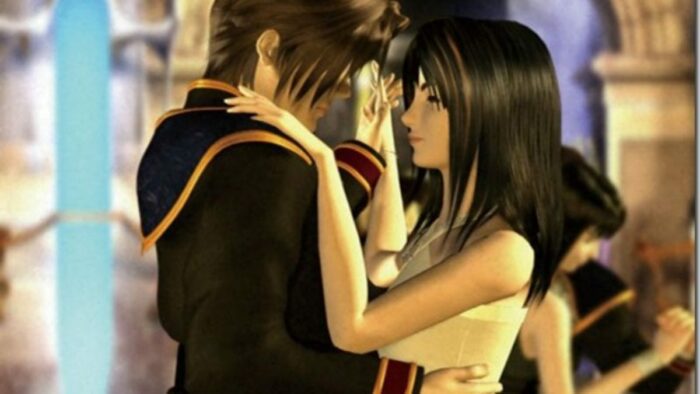
Rinoa is the only character in the party who isn’t a member of SeeD. Squall catches Rinoa’s eye at a graduation ceremony. She confidently walks up to him while he’s drinking alone and asks him to dance with her. He ignores her but she insists. He tells her that he can’t dance. Ignoring this, she grabs him by the arm and drags him to the dancefloor. A CG cutscene shows Squall awkwardly tripping over his feet and bumping into other couples. Rinoa persists and before long the two are gracefully moving together in harmony. It’s a really sweet scene that sets the tone for their relationship. Despite his moody exterior Squall is awkward, shy and lacking self-assurance. Rinoa is carefree and brimming with confidence. She’s able to bring out the best in him.
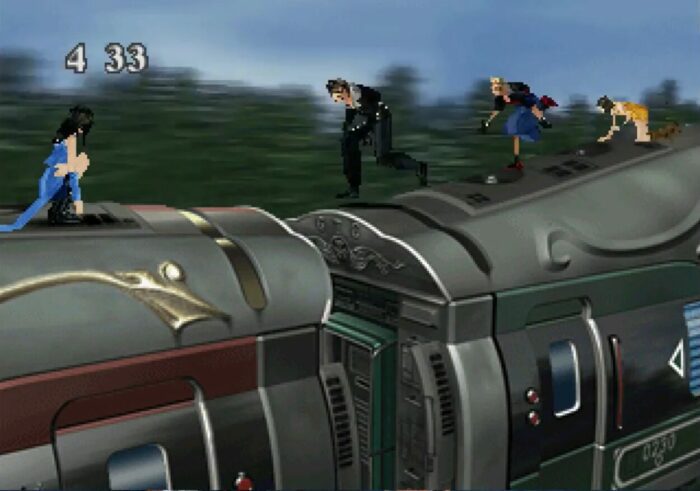
After their initial, fleeting introduction, the pair are thrown together again in a thrilling heist mission. The town of Timber is under occupation and a resistance group, of which Rinoa is a member, ask for SeeD’s aid. The mission involves kidnapping the tyrannical Galbadian president from a moving train. The president’s carriage needs to be uncoupled and replaced with a like-for-like imitation—complete with a dummy president. It’s an exciting set piece that involves the party making their way across the top of the train unseen. While his companions keep watch for guards, Squall quickly inputs codes to uncouple the cars.
The mission, ultimately, turns out to be a trap. The sorceress Edea (now joined by Seifer) is revealed to be the mastermind behind Galbadia’s recent aggression, and the group are tasked with assassinating her. I won’t spoil the whole story here but a bigger threat is unveiled. One that takes the party around the world and beyond.
Despite its themes of resistance, politics and war, Final Fantasy VIII is, fundamentally, a love story. Which seems like a bold choice, when you consider that adolescent boys dominated the gaming scene back then. Much like Squall being reluctantly dragged onto the dance floor, Final Fantasy VIII helped a repressed generation of boys explore their softer side. At least it did for me.
“You’re the one that changes. Not the past.” – Ellone, FFVIII
I loved Final Fantasy VIII’s story and, in particular, its writing when I first played it. Of course, I still do, but the game’s teenage perspective made it resonate so much more with me back then. I found a stark reminder of this during my recent playthrough.
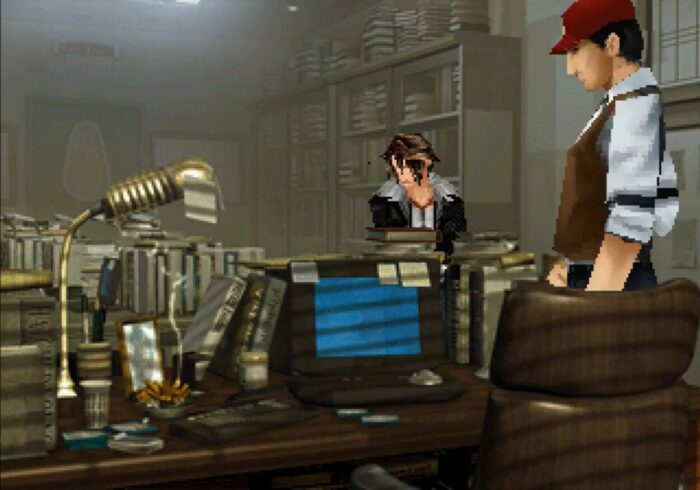
In the occupied town of Timber, there is a publishing company called Timber Maniacs. The Timber Maniacs magazine was a place for young, aspiring journalists to create freelance content. It was deemed too dangerous after the occupation and so was shut down. After all, young voices can be radical and unapologetic, and therefore terrifying to the establishment. The party speak to the editor of the company. He explains how he has been forced to create generic content, such as “photobooks of beautiful women.” At this point Squall tunes out of the conversation and instead his inner monologue takes over.
“…He’s going to go on forever. This is so typical. Adults reminiscing and talking on and on about the things they couldn’t or didn’t do… I hate it.”
As they leave, the editor calls out to them.
“Hey Guys! A word of advice. You’re still young! Don’t let your life pass you by!”
They say nothing and walk out. Needless to say, at the age of 35 I have a very different perspective on this scene than I did back in 1999.
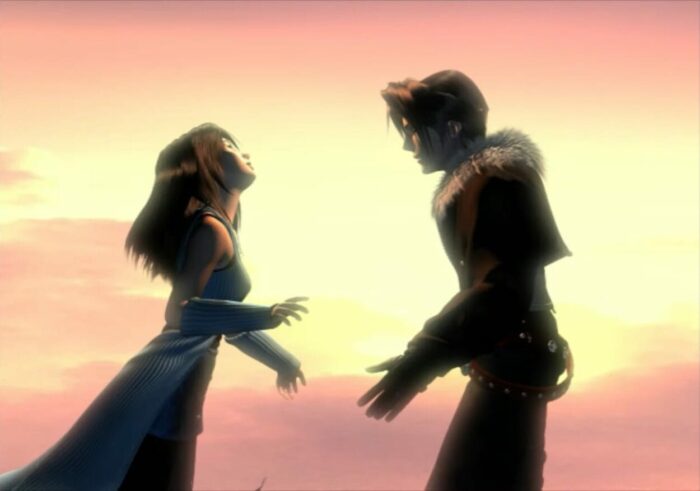
Final Fantasy VIII is a radical entry in the series, and in many ways, it’s the one I look back on most fondly. Its story is dark, moody, witty, and unashamedly romantic. With its battle system it dared to throw out the rulebook and try something different. Despite its shortcomings it’s hard not to admire the attempt. Its graphics wowed the gaming press and public alike in 1999, and its transitions from CG cutscenes to gameplay are still staggering to this day. Triple Triad began a tradition of including an ongoing minigame that future installments would follow. It also has gunblades.
Maybe its reputation as the black sheep of the Playstation-era Final Fantasy games is justified. Then again, who wants to fit in anyway?

